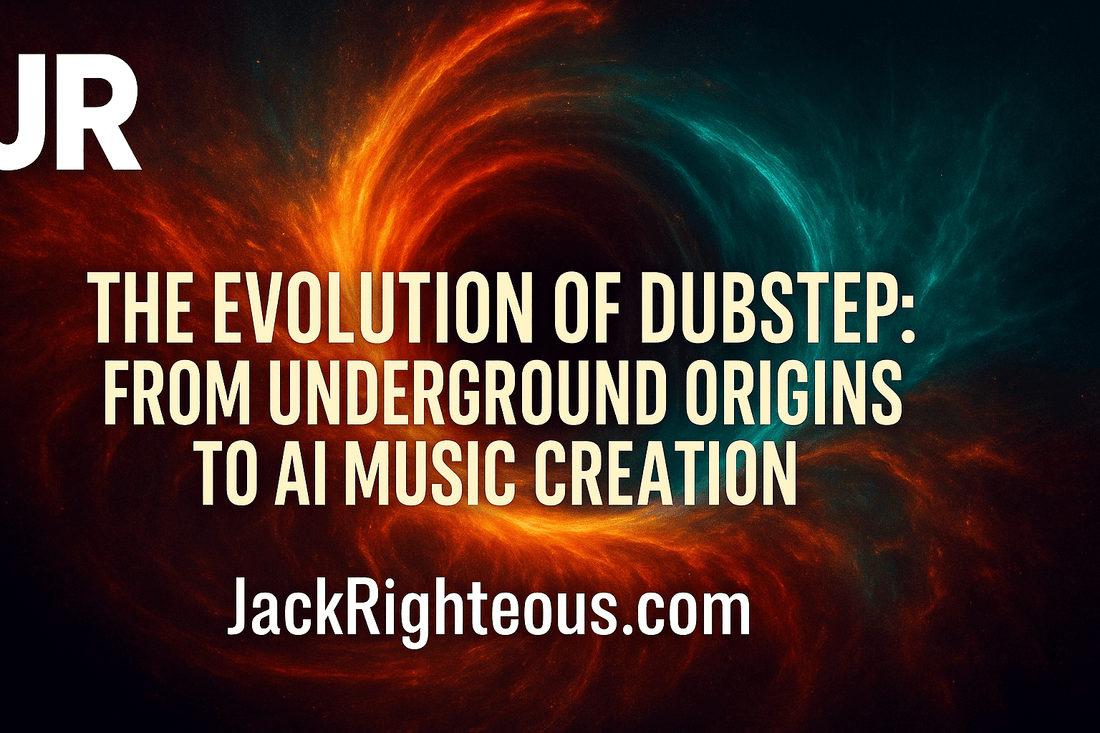
The Evolution of Dubstep: From Roots to AI Music Creation
Gary Whittaker
The Evolution of Dubstep: From Underground Origins to AI Music Creation
Dubstep is a genre that has revolutionized the electronic music landscape with its heavy basslines, syncopated rhythms, and innovative soundscapes. As someone who discovered dubstep in my mid-30s through Skrillex, it not only captivated my musical sensibilities but also helped strengthen my relationship with my son. This personal connection highlights the genre's impact and ability to bring people together. Now, as an AI music creator, I want to delve into the rich history of dubstep and explore how we can leverage AI to create compelling dubstep tracks.
The Origins and Development of Dubstep
Early Influences and Precursors
Dubstep's roots can be traced back to the late 1990s in South London, where it evolved from UK garage, jungle, drum and bass, and reggae. These genres contributed elements like the fast breakbeats of drum and bass, the heavy basslines of reggae, and the syncopated rhythms of garage.
Formation in South London (1998-2002)
Croydon emerged as the epicenter of dubstep's development, with key producers like El-B, Steve Gurley, and Oris Jay experimenting with darker sounds and broken beats. The Big Apple Records shop in Croydon served as a hub for these early pioneers, including Benga, Skream, and Hatcha.
Evolution and Mainstream Exposure (2002-2010)
The genre began to take shape, distinct from UK garage, focusing on minimalism and bass. Pioneering releases on labels like Tempa and influential tracks like Skream's "Midnight Request Line" set the stage for dubstep's rise. Mary Anne Hobbs' BBC Radio 1 show, Dubstep Warz, played a crucial role in bringing the genre to a wider audience.
Key Characteristics of Dubstep
- Rhythm and Tempo: Generally around 140 BPM with a syncopated, half-time feel.
- Bass Lines: Heavy, sub-bass frequencies with wobble bass or LFO-modulated bass.
- Use of Space and Silence: Minimalist approach with contrasts between bass drops and silences.
Creating Dubstep with AI: Leveraging Prompts and Commands
As an AI music creator, harnessing the power of AI to create dubstep tracks involves understanding the genre's key elements and how to prompt the AI effectively.
1. Defining the Rhythm and Tempo
Prompt: "Create a dubstep track at 140 BPM with a syncopated, half-time rhythm."
2. Crafting Heavy Bass Lines
Prompt: "Generate a track with deep, sub-bass frequencies and a prominent wobble bass."
3. Emphasizing Minimalism and Use of Silence
Prompt: "Incorporate minimalist elements with strategic use of silence and powerful bass drops."
4. Incorporating Traditional Dubstep Instruments
Prompt: "Use traditional dubstep instruments like synthesizers, drum machines, and samplers."
5. Creating Dynamic Soundscapes
Prompt: "Design an evolving soundscape with layers of reverb, delay, and modulation effects."
Example Prompts for AI Music Creation:
- Basic Dubstep Track: "Create a 140 BPM dubstep track with heavy bass, syncopated rhythms, and minimalistic drops."
- Wobble Bass Focus: "Produce a dubstep track featuring a prominent wobble bass with LFO modulation."
- Dark and Atmospheric: "Generate a dark, atmospheric dubstep track with deep bass and haunting melodies."
- Experimental Elements: "Incorporate experimental sound design with glitch effects and unconventional rhythms."
- Classic Dubstep Vibe: "Create a track reminiscent of early 2000s dubstep with influences from UK garage and drum and bass."
Dubstep's journey from the underground clubs of South London to the global stage is a testament to its innovative and transformative power. As AI music creators, we can draw inspiration from the genre's rich history and use precise prompts to create tracks that capture the essence of dubstep. By leveraging AI technology, we can push the boundaries of creativity and continue to evolve this dynamic genre.
Thank you for joining me on this exploration of dubstep. For more insights into music creation and AI, stay tuned to JackRighteousMusic.com.
Ready to Launch or Level Up Your AI Music Journey?
🔹 Start Here – The Suno AI Creator Guide:
https://jackrighteous.com/pages/suno-guide-getting-started
🔹 Learn to Brand with Sound – GET JACKED Into Suno Branding:
https://jackrighteous.com/pages/start-ai-music-branding
🔹 Unlock the Full Anthem Path – GET RIGHTEOUS System Access:
https://jackrighteous.com/pages/get-righteous-anthem-guide
(Requires one of the following:
– https://jackrighteous.com/products/get-jacked-full-pro-kit
– https://jackrighteous.com/products/get-jacked-pro-ai-music-kit
– https://jackrighteous.com/products/sanctuary-digital-download-support-the-album-build)

